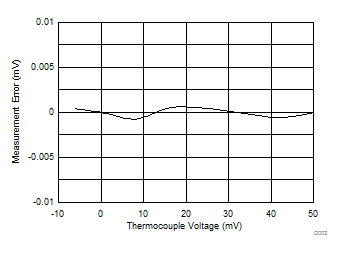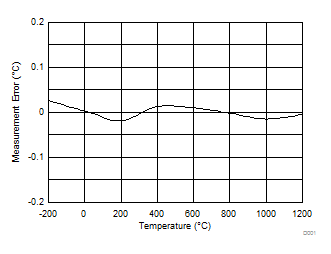SBAS838A January 2018 – October 2018 ADS112U04
PRODUCTION DATA.
- 1 Features
- 2 Applications
- 3 Description
- 4 Revision History
- 5 Pin Configuration and Functions
- 6 Specifications
- 7 Parameter Measurement Information
-
8 Detailed Description
- 8.1 Overview
- 8.2 Functional Block Diagram
- 8.3
Feature Description
- 8.3.1 Multiplexer
- 8.3.2 Low-Noise Programmable Gain Stage
- 8.3.3 Voltage Reference
- 8.3.4 Modulator and Internal Oscillator
- 8.3.5 Digital Filter
- 8.3.6 Conversion Times
- 8.3.7 Excitation Current Sources
- 8.3.8 Sensor Detection
- 8.3.9 System Monitor
- 8.3.10 Temperature Sensor
- 8.3.11 Offset Calibration
- 8.3.12 Conversion Data Counter
- 8.3.13 Data Integrity
- 8.3.14 General-Purpose Digital Inputs/Outputs
- 8.4 Device Functional Modes
- 8.5 Programming
- 8.6
Register Map
- 8.6.1 Configuration Registers
- 8.6.2
Register Descriptions
- 8.6.2.1 Configuration Register 0 (address = 00h) [reset = 00h]
- 8.6.2.2 Configuration Register 1 (address = 01h) [reset = 00h]
- 8.6.2.3 Configuration Register 2 (address = 02h) [reset = 00h]
- 8.6.2.4 Configuration Register 3 (address = 03h) [reset = 00h]
- 8.6.2.5 Configuration Register 4 (address = 04h) [reset = 00h]
- 9 Application and Implementation
- 10Power Supply Recommendations
- 11Layout
- 12Device and Documentation Support
- 13Mechanical, Packaging, and Orderable Information
Package Options
Mechanical Data (Package|Pins)
Thermal pad, mechanical data (Package|Pins)
- RTE|16
Orderable Information
9.2.1.3 Application Curves
Figure 77 and Figure 78 show the measurement results. The measurements are taken at TA = T(CJ) = 25°C. A system offset calibration is performed at T(TC) = 25°C, which translates to a V(TC) = 0 V when T(CJ) = 25°C. No gain calibration is implemented. The data in Figure 77 are taken using a precision voltage source as the input signal instead of a thermocouple. The respective temperature measurement error in Figure 78 is calculated from the data in Figure 77 using the NIST tables.
The design meets the required temperature measurement accuracy given in Table 24. The measurement error shown in Figure 78 does not include the error of the thermocouple itself nor the measurement error of the cold-junction temperature. Those two error sources are in general larger than 0.2°C and therefore, in many cases, dominate the overall system measurement accuracy.

